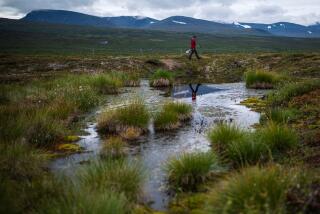Ice sheet melting accounts for 20% of sea level rise since 1992
The loss of ice covering Greenland and Antarctica has accelerated over the last 20 years, shrinking three times as much as in the 1990s and contributing substantially to sea level rise, according to a comprehensive new study of ice sheet loss conducted by 26 laboratories around the world.
The study, published Thursday by the journal Science, comes weeks after Hurricane Sandy’s destruction of coastal communities in New York and New Jersey starkly highlighted the risks posed by sea level rise, especially during storm surges.
Ice sheet loss means that ice that melts during the summer thaw does not return in the winter. That results in a net loss of ice in a year-to-year comparison of a given area.
Supported by NASA and the European Space Administration, the study estimates that about 20% of current sea level rise can be attributed to the 344 billion tons of glacial ice lost annually in Greenland and Antarctica. (The other major factors behind sea level rise are expansion of the oceans as they warm and melting of mountain glaciers, whose waters eventually run into the sea.)
“This study confirms that ice loss is occurring and raising sea levels,” said John Abraham, associate professor of thermal sciences at the University of St. Thomas in St. Paul, Minn., and a spokesman for the Climate Science Rapid Response Team, an information clearinghouse. “For those people who thought that ice sheets were not contributing to sea level rise, they are dead wrong.”
Sea level has risen by about 20 centimeters, or almost 8 inches, since pre-industrial times and the widespread combustion of fossil fuels, whose emissions of carbon dioxide have been the biggest contributor to climate change.
The study resolves a 20-year dispute among climate scientists about “the amount of ice being lost or gained by Antarctica and Greenland,” said professor Andrew Shepherd of the University of Leeds in England, who coordinated the study with research scientist Erik Ivins of NASA’s Jet Propulsion Laboratory in La Canada Flintridge.
The disagreements were fueled in part by differences in satellite data used in more than 30 studies that looked into the link between sea level rise and ice melt in Greenland and Antarctica. To complicate matters, the areas and times covered by the studies weren’t the same, Shepherd said.
So in 2011, the United Nations’ Intergovermental Panel on Climate Change tasked a group of 47 researchers to make sense of the satellite data supplied by NASA and the European Space Administration by comparing readings from the same places and times.
“It brought everyone together. It’s comparing apples to apples,” said coauthor Ian Joughin, a glaciologist in the University of Washington’s Applied Physics Laboratory and lead author on an accompanying review article.
The study found that two-thirds of the annual ice loss came from Greenland and about a third from Antarctica. Though the study found that some ice had been gained in the East Antarctic sheet, the losses in the rest of the continent were far greater.
Sea level has risen an average of 3 millimeters a year since 1992, but the effect is cumulative and accelerating, Abraham said.
“Most people think they don’t have to worry about it, because it’s just a few millimeters,” he said. “But every inch we get makes a storm surge worse.”
You can read a summary of the study online here.
Return to the Science Now blog.







